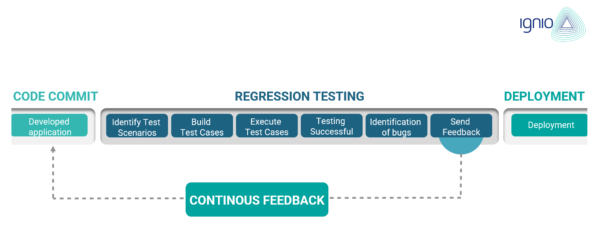Software testing, like software development, has undergone significant changes over the course of time. The traditional waterfall model that was so prevalent in the 90’s and early 2000’s is no longer viable for usage in the era modeled using microservices, agile development, etc.
Though the nuances of software development and testing have evolved, some underlying practices still remain unchanged (for good)! In simple terms, any fix (or new feature) still gets tested & re-tested before it finally goes into production. With release cycles becoming shorter, development & QA teams now rely on Continuous Testing (CT) for accelerating the process of feedback and testing!
Though there are differences between automated testing and continuous testing, you can harness their true potential when the tests are automated and executed in a CI/CD pipeline. Also, every software product goes through a continuous cycle of bug fixes and new feature enhancements.
In complex software systems, bug fixes could also lead to potential side-effects, thereby hampering the working of existing functionalities. Consider the case of an e-commerce application where software fixes in the Cart functionality leads to side-effects in the Payments functionality.
Potential side-effects can be detected by integrating regression tests in the continuous testing pipeline. Since many testers have confusion about regression testing & retesting, it is important to have a know-how of the difference between retesting and regression testing.
Like any other form of testing, manual approach in regression testing works well as long as the product development is in the nascent phase. As more functionalities (or features) make way into the product, a mix of manual and automated approach to regression testing works best! Having said that, automation should always take precedence over manual regression as it offers a slew of benefits.
In this blog post, we explore the advantages of incorporating automated regression testing. Let’s begin our discussion on the topic.
What is Regression Testing used for?
In order to answer the question, let’s take a step back and understand what happens when customers discover issues in functionalities that were already working in the earlier releases? Well, it could prove detrimental if critical functionalities stop working, that too all of a sudden!
Such a scenario could dampen the confidence of your customers (or consumers), which in turn might result in loss of revenue. This is where regression testing can come in handy, as it helps in checking whether code changes (fixes or features) have resulted in any side-effects. Additionally, it assists in verifying that the current features are functioning according to expectations.
When integrated in a CI/CD pipeline, regression tests can be executed as soon as the code is deployed to the test environment. With this approach, testers can unearth issues (or side effects) before they make way into the production. Developers can also be alerted whenever issues are detected during the phase of regression testing.
As regression testing is so critical to maintain product quality, it is recommended to outsource regression testing services for making the most out of this testing approach.
Why Automate Regression Testing?
So far, it is understood why regression tests have to be executed in a continuous pipeline. It is clear that benefits of regression testing can be maximized by automating those tests.
Let’s look at some of the salient benefits of automated regression testing:
Accelerated Feedback Loops
Release-cycles are not only becoming shorter, many product enterprises are also releasing code (i.e. fixes and/or features) many times in a single day! Not running regression tests can turn out to be catastrophic, as potential side-effects could impact the working of existing functionalities.
These situations can be averted by notifying the respective developer(s) about the issue(s), that too in the shortest time possible! Manual approach to regression is not a scalable approach, as you cannot leverage the benefits offered by running regression test suite(s) in a CI/CD pipeline.
Automated regression tests can be seamlessly integrated in a CI/CD pipeline. Tests can be automatically kicked-in whenever developers fix issues, introduce new features, or add configuration-level changes in the development cycle.
For instance, automated regression tests can be integrated with popular CI tools like Jenkins, CircleCI, etc.; eventually helping in accelerating feedback cycles. All these factors are instrumental in shipping top-quality well-tested features that do not break the code
Also Read: Different Ways To Manage Regression Testing Challenges
Increased Test Coverage
Test coverage is an important factor that helps in covering (or testing) every aspect of the development code via tests. Test coverage is a good metric to measure code quality, since different code-paths are covered via the implemented tests.
There is a difference when it comes to test coverage and test coverage, hence recommend this code coverage vs test coverage blog that deep dives into the differences. Higher test coverage by no means guarantees that every aspect of the implemented code is tested to the fullest.
However, test coverage does play a role in enhancing the overall quality as edge cases (or corner conditions), negative tests, etc. are normally covered during the testing phase.
The above-mentioned pointers also apply to automated regression tests, as those tests also catalyze in improving the code quality. The regression test suite also undergoes changes and enhancements, as more features make way into the product development.
In a nutshell, automated regression tests are more instrumental in increasing the overall test coverage and improving the product quality.
Reduced Maintenance Efforts
Manual regression tests are neither useful in increasing test coverage, nor are they effective in reducing maintenance efforts. Automated regression testing definitely has a huge upper hand when it comes to test maintenance.
Maintenance of regression tests could cause nightmares if more emphasis is laid on E2E (End-to-End) tests when compared to feature-level tests. The automated regression test suite focuses on maximizing the number of functional tests to reap the benefits offered by regression and automation!
Different copies of regression test suite(s) corresponding to the respective software release(s) provide much-needed insights into the progress on development and testing fronts. On the whole, reduced maintenance efforts goes a long way in scaling up the regression test suite overtime.
Also Read: How To Achieve Shift Left With Unit Regression Testing?
Integration With CI/CD Pipeline
It is a no-brainer that manual tests (of any test type) cannot be run continuously in a CI (Continuous Integration) pipeline. The same principle also applies to regression testing.
As stated earlier, faster developer feedback loops are possible by integrating automated regression testing in a CI/CD pipeline.
Over & above, incorporating the fail-fast approach in automated regression tests can be hugely beneficial in reducing the test execution time. Regression test execution can be strategically paused (or halted) on failure of highly critical tests that might be a showstopper for the respective release. In a nutshell, automated regression tests when run in a CI pipeline offer benefits that cannot be achieved using the manual approach.
Lastly, automated regression tests are easy to scale and reuse thereby helping save critical man-hours that can be further accommodated to perform other important tasks.
Conclusion
Regression tests are integral in ensuring that feature enhancements and bug fixes do not hinder the working of existing functionalities. Regression tests become super impactful when they are automated and executed as a part of the CI pipeline.
Lending the expertise of an experienced regression testing services company like KiwiQA can prove beneficial in accelerating release cycles and empowering development & QA teams at scale. All of this leads to improved product quality and faster go-to-market – key factors to stay ahead of the competition.









